Samsung Galaxy Buds Pro vs AirPods Pro: Which noise-canceling wireless earbuds win?
Our AirPods Pro vs. Samsung Galaxy Buds face-off breaks down which noise-canceling wireless earbuds are best for you

This AirPods Pro vs. Samsung Galaxy Buds Pro comparison breaks down two of the market’s most coveted noise-canceling wireless earbuds models, helping you decide which is best for your needs and budget.
The AirPods Pro has been revered as a top performer in its class, delivering excellent performance for a premium. Apple’s wireless danglers pack great active noise cancellation, adaptive sound, and plenty of iOS-friendly features into a more durable and customizable design. We recommend checking out our Apple AirPods Pro review to see why it earned a perfect score.
- The best wireless earbuds you can buy
- Check our the best noise canceling headphones
- 2021's best headphones deals (so far)
New onto the scene, the Samsung Galaxy Buds Pro looks to undercut the competition, boasting a strong spec sheet and some exclusive perks for Samsung device owners at a lower price point. We’re talking intelligible ANC, optimized audio, and seamless connectivity with Galaxy devices just to name a few.
Even though the AirPods Pro are some of the best headphones overall, the Galaxy Buds Pro should not be overlooked. After a week of testing, we’ve determined a winner. Read on to see which model is the better true wireless noise-canceling solution.
AirPods Pro vs Samsung Galaxy Buds Pro: Specs compared
| Header Cell - Column 0 | AirPods Pro | Samsung Galaxy Buds Pro |
|---|---|---|
| Price | $249.00 | $199.99 |
| Wireless Charging Case | Yes, included | Yes, included |
| Chip | H1 | Broadcom BCM43015 |
| Battery Life (Rated) | 4.5 hours with ANC on, 5 hours with ANC off (24 hours with charging case) | 5 hours with ANC on (18 hours with charging case), 8 hours with ANC off (28 hours with charging case) |
| Water Resistance | IPX4 (can withstand sweat and water, but not for use in water sports) | IPX7 (can withstand sweat and submersion up to 1 meter in water) |
| Case Size | 2.39 x 1.78 x 0.85 inches | 1.96 x 1.97 x 1.09 inches |
| Case Weight | 1.61 ounces | 1.58 ounces |
| Special Features | Active noise cancellation, transparency mode, adaptive EQ, customizable fit, Spatial Audio, audio sharing, wireless charging | Active noise cancellation, transparency mode, Voice Detect, SmartThings Find compatibility, Wireless PowerShare support |
AirPods Pro vs. Samsung Galaxy Buds Pro: Price
You will be spending big coin on either set of buds. The AirPods Pro launched at $249 and remains at this price point, though we have seen it on sale several times, going for as a low as $199. Check out our AirPods sales page for the latest sales and discounts.
As a new release, the Galaxy Buds Pro will run you $199.99, which is cheaper and a better value than the AirPods Pro based on functionality. If the price is still too high for your budget, check out Samsung’s current promotion that has the buds available for $149.99 with eligible trade-in. Also, keep in mind that big retailers (e.g., Best Buy, Walmart) are known for offering special deals, which may come in the form of a Galaxy S21 smartphone bundle, so keep your eyes peeled.
Winner: Samsung Galaxy Buds Pro
Sign up to get the BEST of Tom's Guide direct to your inbox.
Get instant access to breaking news, the hottest reviews, great deals and helpful tips.
AirPods Pro vs. Samsung Galaxy Buds Pro: Design

The AirPods design is not attractive. Period. Granted, Apple did implement some changes to make this noise-canceling version more distinctive and practical. There’s the longer sound port for enhanced fit, shorter stems with silver accents at the bottom, the all-new force sensor control, which is awesomely underrated, and a black vent system for equalizing pressure.
Samsung did the smart thing by ditching the bean-shaped design of the Galaxy Buds Live in favor of the more conventional oval design adopted by earlier Galaxy Buds models. Not only does this present a more discrete and sleeker appearance, but also allows for improved control input, with the front housing a larger touch panel. An outer mic has been placed on the front as well and comes protected with a windshield chamber, while a second mic is located at the top, along with an air vent on the top inner part of the buds.

Both pairs of earbuds have sweat and water-resistant protection, though the Galaxy Buds Pro has the superior IP certification: IPX7. All this means is that the buds can be submerged in up to 1 meter of water for 30 minutes without suffering any damage. The AirPods Pro comes with a IPX4 rating, which is enough for sweat and splashes but not full submersion.
The Galaxy Buds Pro also offers more colors. You can pick from three exciting options: Phantom Violet, Phantom Black, Phantom Silver. The AirPods Pro, well, you already know the answer to that (spoiler: it’s white, and white only).
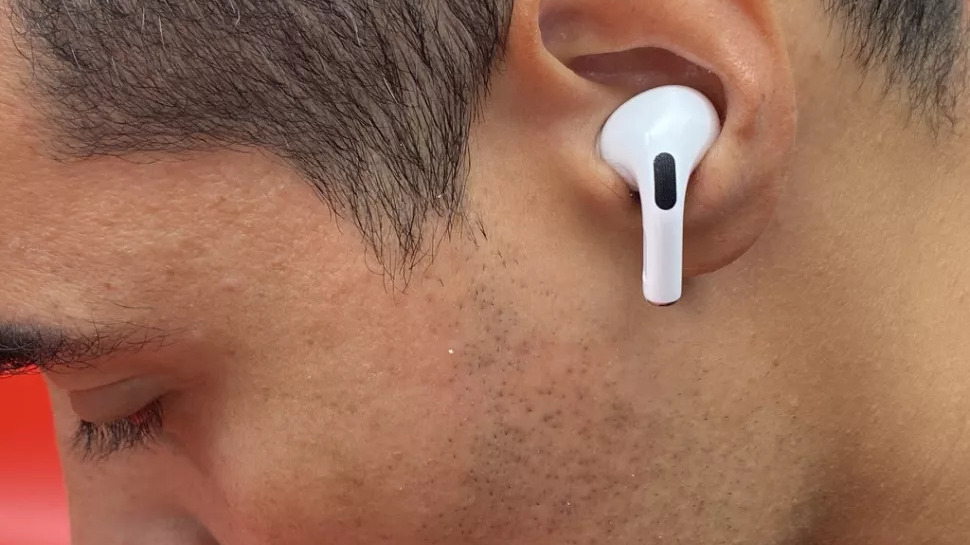
Next, let’s talk charging cases. Those familiar with the AirPods line know what they’re getting: a chic and portable piece of plastic that fashionably stores the buds, but doesn’t provide the greatest protection. The exterior scuffs up easily and the magnets are weak, meaning the buds will spill across the floor whenever dropped to the ground. On the other hand, the Galaxy Buds Pro’s case is more compact, stylish, and beautifully displays the buds, though I would be remiss if I didn’t mention its flimsy lid.
One of the major upgrades introduced on the AirPods Pro was the customizable fit. The inclusion of silicone tips makes a world of difference for on-ear stability. These tips, along with Apple’s Ear Tip Fit Test that calibrates the buds and determines the best tips for the user, also helps make the AirPods Pro one of the best sport headphones out there.

We give Samsung points for originality with the Galaxy Buds Live’s bean-inspired design, but the execution was poor and that compromised fit. Going back to basics was the way to go, as the Galaxy Buds Pro’s oval shape lets you nestle the buds more easily into the ear to create a decent seal when properly adjusted. You may feel some discomfort around the concha after an hour of use, but that depends on your pain threshold.
Winner: Samsung Galaxy Buds Pro
AirPods Pro vs. Samsung Galaxy Buds Pro: Controls

As cool and convenient as touch controls are, Apple’s force sensors remain the best input method for wireless earbuds. They take some getting used to, but once you get a feel for them, everything from playback to turning on ANC becomes a breeze to operate. My only complaint is that you’re limited by the number of controls you can assign to each bud.
Where the AirPods Pro really shines is in voice activation, which is superbly demonstrated by the hands-free “Hey Siri” feature. It instantly recognizes commands, has great speech recognition, and operates smoothly on iOS/macOS devices.

Samsung’s buds are loaded with several smart controls that make the most of the larger and more intuitive touch sensors, which offer better touch accuracy. A variety of touch and hold gestures are made available, along with the ability to designate and swap out controls for more useful ones (e.g., volume up/down). Like the AirPods Pro, the Galaxy Buds Pro also comes with on-ear detection to automatically pause music when removing the buds. The feature works better on Apple’s buds; for some odd reason, playback won’t resume when placing the Galaxy Buds Pro back on your ears.
It’s nice of Samsung to offer its own AI bot and voice wake-up option for the buds (“Hi Bixby,” but it can’t compete with Siri. Apple’s voice detection is spot-on and instantly wakes when called upon. Oftentimes, I noticed Bixby struggled to recognize its own activation phrase, as well as some voice commands.
Winner: AirPods Pro
AirPods Pro vs. Samsung Galaxy Buds Pro: Audio quality

Another area where the AirPods Pro shocked us was audio quality: it’s seriously impressive. This is attributed to Apple’s adaptive EQ; it automatically adjusts the EQ levels on the fly based on your ear shape and what you’re listening to.
The difference in sound between the standard AirPods and AirPods Pro is huge, as the latter blesses your ears with clean, warm sound to enjoy Apple Music playlists on the go. The addition of Spatial Audio is another win for the AirPods Pro that makes watching video content more immersive by creating theater-like surround sound. We love Spatial Audio and are happy to see that Apple has carried it over to the all-new AirPods Max, along with future audio products that run iOS 14.
Despite the lack of a customizable EQ, Apple does let you modify the sound in the iPhone settings with 20 different presets that cater to different music genres and media formats.
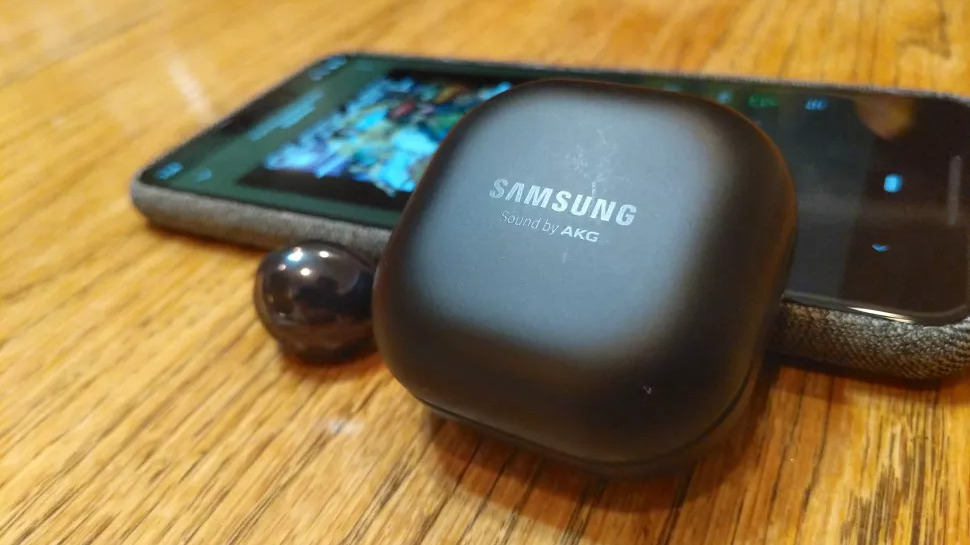
Audio has been one of Samsung’s greatest strengths and the Galaxy Buds Pro benefits from a nice sonic boost, thanks to a new two-way speaker system (11mm woofer and 6.5mm tweeter) that pumps out deeper bass and richer treble. The drivers are powered by Harman too, meaning you can expect top-notch sound. Samsung’s Scalable Codec produces high-fidelity results when listening to music on newer Galaxy smartphones, which makes orchestral and bass-heavy recordings sound terrific. And despite the minimal loss in quality when streaming on non-Samsung devices, the buds still produce dynamic audio, no matter the platform or music service.
The Galaxy Buds Pro do lack a fully customizable EQ, though the accompanying Galaxy Wearable app does have six presets to choose from. This pales in comparison to what the AirPods Pro can offer, but it is still serviceable should you want to prioritize specific details like clearer vocals or emphasized lows.
Samsung has also introduced its own spatial audio alternative, 360 Audio, using Dolby Head Tracking to create “multi-dimensional sound.” Sadly, the feature is only available on Galaxy smartphones running OneUI 3.1 (or higher), which, at the moment, is only available on the new Galaxy S21 phones. Since we weren’t given a S21 model with our Galaxy Buds Pro review unit, we can’t offer any insight on 360 Audio at the moment, but we hope to update this section once given the opportunity to test the feature.
Winner: Samsung Galaxy Buds Pro
AirPods Pro vs Samsung Galaxy Buds Pro: Active noise cancellation

Apple’s active noise cancellation is not to be underestimated. Many wireless earbuds makers have challenged the AirPods Pro’s ANC – many have failed in the end (read our other face-off features to see which ones). The company’s two-mic noise-canceling system is a workhorse that silences close to 85% of external sounds. We found the technology to be highly effective both indoors and outdoors, keeping common distractions (e.g., door buzzers, loud TVs, neighborly chatter) to a minimum, though high-frequency sounds are where the feature shows chinks in its armor. Oftentimes, noises like car alarms and whistles will make their way onto the soundstage.

Samsung says the Galaxy Buds Pro comes with the “most intelligent ANC capabilities of any true wireless earbuds” and can reduce “99 percent” of background noise. Our hands-on with the buds determined this to be false. Not even the best wireless earbuds for noise cancellation, the Bose QuietComfort Earbuds, are capable of blocking out that much ambient sound. That doesn’t mean the Galaxy Buds Pro isn’t serviceable for noise neutralization. You get Low and High settings to choose from, the latter being more powerful and useful for indoor settings. These buds are capable of silencing many of the same distractions as the AirPods Pro, but poor wind resistance makes them ineffective outside.
Each model has their own Transparency Mode, which is useful to spark brief conversations or gain better awareness of surroundings without pausing playback. Apple’s version does a pretty good job of letting in voices to communicate clearly and works even better when used outside to hear traffic.
Samsung says its four-level Transparency Mode is “better than it has ever been,” and that is a fact. Enabling it will amplify the external sounds around you to hear clearly what is happening around you. The company also introduces a new Voice Detect feature that works conjointly with Transparency Mode, automatically decreasing playback volume when sensing the user speak and increasing audio passthrough volume to clearly converse with others. It’s OK, though it does have issues with lag.
Winner: AirPods Pro
AirPods Pro vs. Samsung Galaxy Buds Pro: Special features and apps
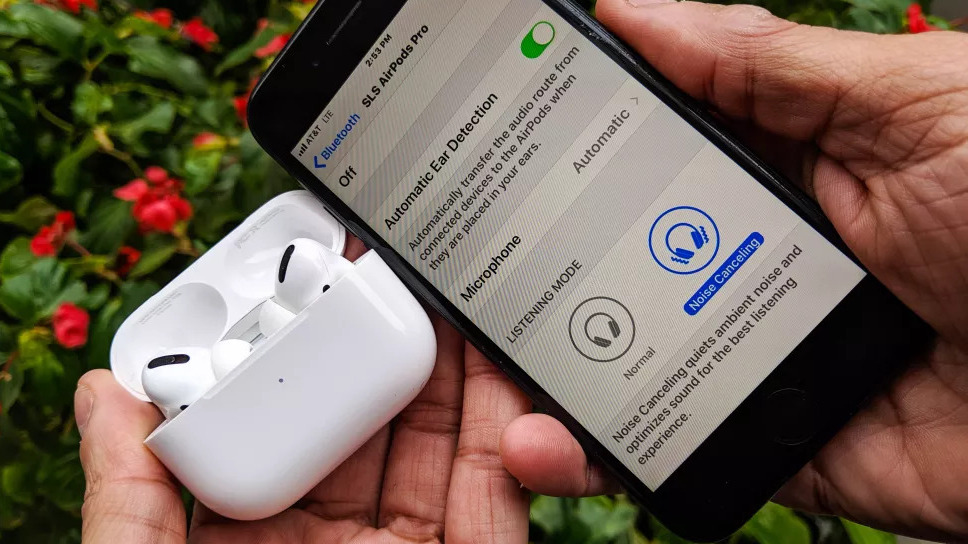
Nothing really compares to the overall performance that Apple’s H1 processor grants AirPods owners. Its beauty lies in the ability to take on newer features via firmware updates, no app or hardware upgrades required. Besides flawless iOS integration (e.g., instant connectivity to iDevices, Hey Siri voice activation), the H1 chip presents numerous other perks, including audio sharing between two Apple headphones, automatic switching, longer talk times, and the aforementioned spatial audio. And if we’re following Apple’s track record, future iOS 14 updates will bring more into the mix.

The Broadcom BCM43015 processor is what operates the Samsung Galaxy Buds Plus. Whether Samsung has built its own dedicated ANC chip for the buds is undetermined. These are some fast-operating buds that come with their own set of features for Android users, as well as some exclusive ones for Galaxy smartphones. All Android users gain access to the EQ settings, control customization, and one-touch Spotify access. Galaxy device owners receive Auto Switch to instantly pair the buds with other Galaxy devices, Gaming Mode to decrease audio lag when playing video games, improved Bixby voice wake-up response, left/right sound balance adjustment, and SmartThings Find, a new feature that detects lost devices on other Galaxy devices and sends a notification on where it was last discovered.
Everything is pretty much accessible through the Galaxy Wearable app on Android. Sadly, the Galaxy Buds Pro doesn’t support the Galaxy Buds app on iOS, meaning iPhone and iPad users can use the buds, but can’t change the settings or update them.
Winner: AirPods Pro
AirPods Pro vs. Samsung Galaxy Buds Pro: Call quality
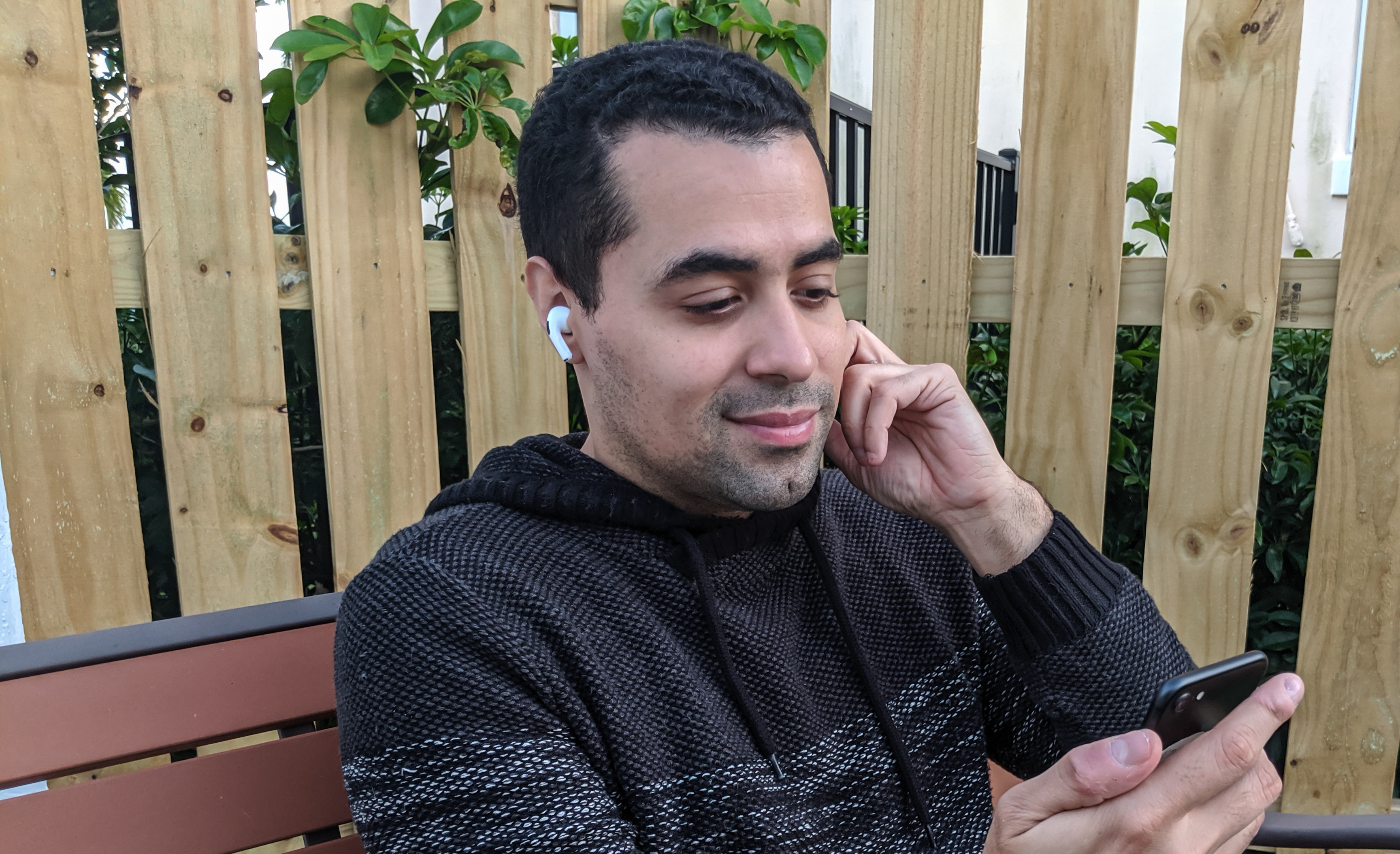
Call quality on the AirPods Pro is excellent and only second to the QuietComfort Earbuds. You can expect clear-sounding calls in any environment, along with strong wind resistance to maintain conversations in drafty conditions. The mics also do a fantastic job of picking up voices and delivering great speech recognition when firing up Siri.
Call quality is better on the Galaxy Buds Pro than the Galaxy Buds Live, but Samsung still needs to fix a few things. You will get some great service on video calls, with voices sounding loud and crisp on both ends. Unfortunately, the combination of a Voice Pickup Unit (VPU), Wind Shield technology, and the same mic system doesn’t work well outside; I had a few people complain about how choppy and slightly distorted I sounded.
Winner: AirPods Pro
AirPods Pro vs. Samsung Galaxy Buds Pro: Battery life

Battery life is nearly identical between these two models. The AirPods Pro comes in at 4.5 hours with ANC on and the Galaxy Buds Pro, while rated slightly higher at 5 hours, is realistically about 4 to 4.5 hours when factoring in the listening modes and high volume. Apple claims that disabling ANC will push playtimes on the AirPods Pro to 5 hours, placing it in the same company as (you guessed it) the AirPods 2. Meanwhile, the Galaxy Buds Pro can extend playtimes up to 8 hours when disabling several features.
The real MVP here is battery management, which is remarkable on the AirPods Pro. Apple’s buds are optimized to learn your charging routine and wait to charge past 80% until you need to use them, while squeezing every bit of juice out of each charge for longer use. With the Galaxy Buds Pro, you’re forced to turn off ANC and Bixby in order to extend playtimes, and even doing so doesn’t get you the advertised amount (it’s more like 7 hours).
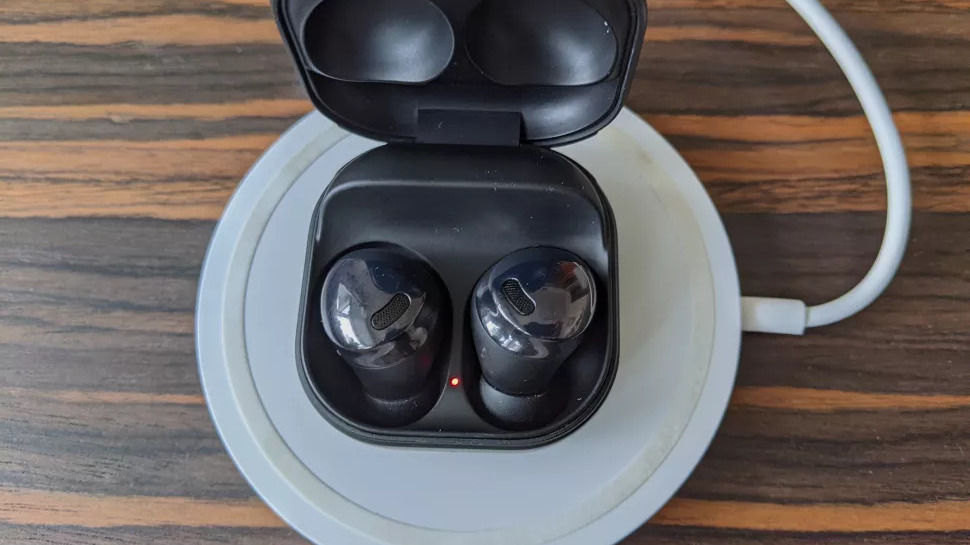
Both products come with wireless charging cases that are compatible with Qi-based wireless chargers. Apple’s case holds up to 24 hours total, with a 5-minute charge earning you 1 hour of use. The Galaxy Buds Pro not only produces the same quick-charging results, but also supports the company’s signature Wireless PowerShare technology to charge the buds by placing the case on the back of a compatible Galaxy smartphone.
Winner: Tie
AirPods Pro vs. Samsung Galaxy Buds Pro: Verdict
Samsung continues to chip away at Apple with every new true wireless release, but the AirPods Pro’s stellar overall performance, along with Apple’s commitment to improving on near perfection with every software update, makes these buds the clear winner. The responsive controls, great audio quality, wide range of features, and excellent call quality are hallmarks that speak for themselves. However, it’s noise cancellation that places the AirPods Pro in the upper echelon, letting you enjoy music in peace for the most part. Battery life and design (a revamp is in order, Apple) still need to be addressed, but if neither of these flaws bothered you on previous AirPods models, then they certainly won’t here.
| Header Cell - Column 0 | AirPods Pro | Samsung Galaxy Buds Pro |
|---|---|---|
| Price and value (5) | 3 | 4 |
| Design (15) | 11 | 13 |
| Controls (10) | 9 | 8 |
| Audio quality (20) | 17 | 18 |
| Active noise cancelation (20) | 17 | 15 |
| Special features and apps (15) | 13 | 12 |
| Call quality (5) | 5 | 3 |
| Battery life (10) | 7 | 7 |
| Total score (100) | 82 | 80 |
The Galaxy Buds Pro stands out as the company’s best wireless earbuds to date and are a notable upgrade that both Android and Galaxy smartphone users will appreciate. These buds are aesthetically pleasing, produce lively sound, and have plenty of features to toy with, even if some of the best ones are reserved for newer Galaxy smartphones. Noise cancellation is adequate as well. And though battery life and call quality are disappointing, they could be much worse.
Despite the AirPods Pro being the superior model, and the ideal iPhone 12 companion, Android fanatics will find amazing use for the Galaxy Buds Pro, no matter the platform.
- More: Our list of the best noise-cancelling earbuds right now
A lifestyle journalist with an affinity for consumer products, Alex has over a decade of experience and has worked with popular publications such as Complex, Thrillist, Men’s Health, Gear Patrol, AskMen, and Hoop Magazine. He currently focuses on audio, reviewing the most coveted headphones in the market for both Tom’s Guide and Laptop Magazine.

